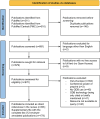Graph databases in systems biology: a systematic review
- PMID: 39565895
- PMCID: PMC11578065
- DOI: 10.1093/bib/bbae561
Graph databases in systems biology: a systematic review
Abstract
Graph databases are becoming increasingly popular across scientific disciplines, being highly suitable for storing and connecting complex heterogeneous data. In systems biology, they are used as a backend solution for biological data repositories, ontologies, networks, pathways, and knowledge graph databases. In this review, we analyse all publications using or mentioning graph databases retrieved from PubMed and PubMed Central full-text search, focusing on the top 16 available graph databases, Publications are categorized according to their domain and application, focusing on pathway and network biology and relevant ontologies and tools. We detail different approaches and highlight the advantages of outstanding resources, such as UniProtKB, Disease Ontology, and Reactome, which provide graph-based solutions. We discuss ongoing efforts of the systems biology community to standardize and harmonize knowledge graph creation and the maintenance of integrated resources. Outlining prospects, including the use of graph databases as a way of communication between biological data repositories, we conclude that efficient design, querying, and maintenance of graph databases will be key for knowledge generation in systems biology and other research fields with heterogeneous data.
Keywords: NoSQL databases; RDF; graph databases; network biology; ontology; systems biology.
© The Author(s) 2024. Published by Oxford University Press.
Figures
References
-
- Kitano H. Systems biology: a brief overview. Science 2002;295:1662–4. - PubMed
Publication types
MeSH terms
Grants and funding
LinkOut - more resources
Full Text Sources



